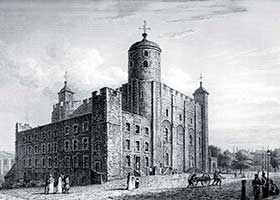Ravens in the Tower of LondonRavens in the Tower of London - Information & Facts about the Ravens in the Tower of London
- The legend of the Tower's Ravens
- The Ravens Lodgings in the Tower of London Castle
- The duties of the Ravenmaster
The Legend of the Ravens in the Tower of London
The Legend of the Ravens in the Tower of London was instigated, in the main, to a Medieval chronicler called Geoffrey of Monmouth. The stories of many Welsh Celtic legends and Myths, and their authenticity, were raised by Geoffrey of Monmouth. In 1136 Geoffrey of Monmouth wrote a book called Historia Regum Britanniae - the History of the King's of Britain. In this book Geoffrey of Monmouth refers to an early British King called King Bran Hen of Bryneich (born c.485). The Welsh word for Raven is Bran. This ancient King of the Dark Ages was killed in a battle and requested that his head was buried, as a talisman against invasion, on Gwynfryn (the 'White Mount') where The Tower of London now stands. To this day ravens are accepted as highly important and necessary occupants of the Tower of London. Legend has it that should the ravens ever leave the Tower of London the White Tower will crumble and a great disaster shall befall England. The Ravens in the Tower of London and King Charles II
King Charles II is believed to be the Monarch who decreed that at least six ravens should be kept at the Tower at all times to prevent disaster. The unconfirmed story of his involvement was prompted by a request from John Flamsteed (1646 - 1719), the 'astronomical observator'. The Royal Observatory was housed in the north eastern turret of the White Tower and John Flamsteed complained to King Charles II that the ravens were interfering with his observations. The King ordered their destruction but was told that if the ravens left the Tower of London that the great White Tower would fall and a terrible disaster would befall England. Not wanting to tempt fate by flouting ancient legend King Charles changed his mind and decreed that at least six ravens should be kept at the Tower at all times to prevent disaster. Raven's Lodgings and the Ravenmaster in the Tower of London
In deference to the ancient legend and the decree of King Charles II at least six ravens are provided with Raven's Lodgings at the Tower of London. A Yeoman Warder, or Beefeater, has the specific role of Ravenmaster at the Tower and takes care of their feeding and well being. Ravens can be quite vicious birds and they only respond to the Ravenmaster. The Ravenmaster builds this relationship with the ravens as he takes the fledglings into his home and hand rears them over a period of about six weeks. Ravens live up to an average of 25 years, but have been known to reach the age of 45 years. To prevent the birds from flying away one of their wings is clipped by the Ravenmaster. This does not hurt or harm the raven in any way. Clipping their wing unbalances their flight ensuring that they don't stray too far from the Tower. Ravens are members of the crow family, Corvus, and are eaters of carrion and live mainly on dead flesh. The Raven's lodgings are located next to the Wakefield Tower and are kept at the Tower of London at the expense of the British government. | 
